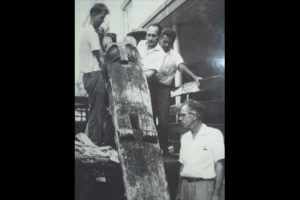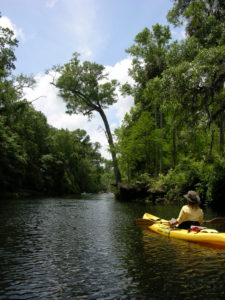 Hontoon Island Kayak (& Canoe) Tour
Hontoon Island Kayak (& Canoe) Tour
Group size: 1 – 24
Trip time: 4.5 – 5 hours
Skill level: Intermediate, narrow winding creek can be a challenge for novices
Cost
Most guided tours are $50 per person. (includes boat, paddle, vest, shuttling and your guide)
Using your Own Boat – $40. (many paddlers with their own boats like to join us to learn more about the history, archaeology and natural history of these rivers).
Dates
Join a scheduled tour (see tour calendar ), or suggest one. Find a free date on the calendar and suggest the trip of your choice. If there are no conflicts, we’ll post it!
OR
Schedule a private tour. Use contact form, email us at [email protected] or call (386-454-0611)
Location
Check the River Locator Map or Click the link below for a local map and then use zoom and panning arrows to explore the area. (Note: the marker is NOT our meeting place, but a nearby landmark.
Local MapDescription
This is the only trip where we visit two State Parks in one day. On this trip we explore the many faces of Hontoon Island, an interesting, 1650 acre island of pine flatwoods and hardwood hammock nestled within a broad ring of wetlands – mostly cypress swamps.
We’ll begin by coasting the islands west face, where it fronts a quiet backwater called Hontoon Dead River (the St. Johns basin is loaded with “dead” rivers, a handle alluding to the fact that, unlike some side channels, these do not reconnect to the main channel. Apparently, the namers weren’t paddlers. To us, there’s nothing more vibrantly alive than these “dead” rivers! 🙂
Easing southward, the graceful curves of Hontoon Dead carry us past the islands swamp forests, where shady groves of cypress, ash, oak, hickory and tupelo shroud ancient memories of a long line of native inhabitants. Our attempts to conjure images of those distant lives is helped somewhat by a collection of three totem poles dredged from these waters in the 1950’s and 70’s, Expertly carved figures of an owl, pelican and an odd otter/frog creature holding a fish, strengthen our sense of connection to a people who cared for nature as much as we do.
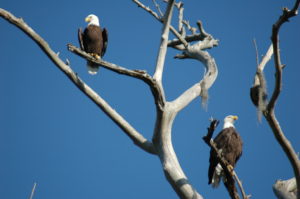 Soon we pass Snake Creek on our left. This aptly named, slithering stream offers a scenic connection to the St. Johns as it defines Hontoon Islands south face. In higher water levels this is doable, but at present is nothing more than a tease – all show and no flow. We continue southward. After another half hour of alternating open marsh and narrower, forest-lined channel, we find ourselves on the open St. Johns River, compliments of an old logging canal.
Soon we pass Snake Creek on our left. This aptly named, slithering stream offers a scenic connection to the St. Johns as it defines Hontoon Islands south face. In higher water levels this is doable, but at present is nothing more than a tease – all show and no flow. We continue southward. After another half hour of alternating open marsh and narrower, forest-lined channel, we find ourselves on the open St. Johns River, compliments of an old logging canal.
Osprey, vultures, eagles and many water birds keep us entertained as we move downstream (northward). Our next stop is Blue Spring State Park. Here, we’ll land and walk in to look at the beautiful spring and it’s most popular winter residents – the manatees. Swimmers and boaters are all prohibited from these waters as the manatees go about the business of eating, enjoying life and surviving the winter in a natural, snorkel-free environment. What a relief to see conservation over-ruling commerce!
After our brief stop over at Blue Spring, it’s back to the boats for the last leg of our trip. Riding the slow, gentle flow of the St. Johns, we coast the east shore of Hontoon Island. After passing a corner of Lake Beresford, one of the many lake-aneurysms bulging dramatically from the main artery of the St. Johns, we return to the launch site – completing this 9 mile, 4.5 hour loop.
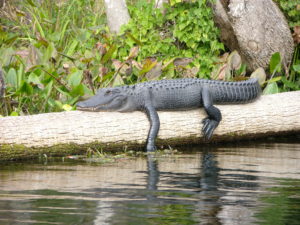 Wildlife
Wildlife
This is a great trip for spotting alligators. Not only because there are plenty of them, but because the channels are plenty wide to allow you and them to easily avoid each other. Water birds thrive here as well. Of the heron clan, great blues are often the most prevalent, but little blues, snowy egrets and great egrets also live and feed here. Osprey are regular companions as are vultures. Bald eagles are often spotted in the mix.
If you camp on the island, be prepared for an all-night serenade by the islands many barred owls. Another species which enjoys spending the evening on Hontoon Island, though in a quieter fashion, are vultures. Black and turkey vultures by the hundred often roost in the trees, especially on the observation platform on the north end of the island. Deer are also plentiful.
Ever heard an owl quack? The barred owl’s genus name, Strix, is Latin for “screech,” but it’s usual call sounds like “who cooks for you?” Sometimes the call escalates into a weird cacophony of howls and quacks that sounds like a Chihuahua with a duck stuck in it’s throat. This is Florida’s second largest owl, barely smaller than the Great Horned Owl. These birds of prey are well adapted to their nocturnal lifestyle because of exceptional night vision, made possible by having extra-long, light-gathering rods in their eyes. One drawback to having such lengthy rods is that it gives the owls eyeballs a tubular rather than round shape, and makes it impossible for them to roll their eyeballs. Thus, the characteristic ‘swiveling head’ of attentive owls.
History
While digging a canal in the 1950’s, workers brought up a carved wooden “totem” of an owl from the river bottom. Later, in the 50’s, another totem was pulled up by a dredge being used to work on submerged cables – this one of a pelican. This brought a rush of archaeologists whose thorough search of the river bottom revealed a totem of an otter holding a fish. These are the only such wooden totems found anywhere in North America, aside from the Pacific Northwest.
The descendants of the totem artists enjoyed many more centuries, living and dying in their river side villages, before the first European explorers ever entered their world. That first encounter came in the 1560’s, when Pedro Menendez led an exploratory mission up the St. Johns. After crossing Lake George, he met these people, known as the Mayaca and asked permission to pass. He did not get it. After passing a barricade of log spikes Menendez ascended deeper into Mayaca territory. As the river narrowed, he realized he could easily fall into an ambush set by these reportedly fierce warriors, and wisely turned back
As the long arm of the Spanish mission system swept north Florida, the Mayaca region was at the southern fringes of activity and was therefore spared – for a while. Eventually, as the north Florida natives were decimated, the Spanish started looking closer at Mayaca. Several missions were established in south central Florida and the upper St. Johns. In the end, all that remained of the people of Hontoon Island were scores of shell middens and burial mounds and a few totem poles. Today, their somber wooden eyes look out from the glass encasements of the Florida Museum of Natural History.
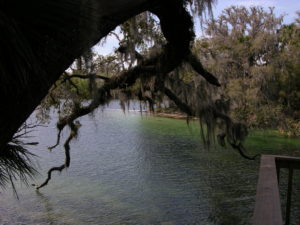 A century and a half later, after the last of the Mayacas and their successors, the Seminoles were driven out of the upper St. Johns, a veteran of the Second Seminole War named William Hunton settled on the Island. It is from his name, though skewed and tattered from the passage of time and countless lips, that the name Hontoon was derived. From that time to this, the Island changed hands several times and was used alternately as a boat yard and cattle ranch. The State bought the island in 1967.
A century and a half later, after the last of the Mayacas and their successors, the Seminoles were driven out of the upper St. Johns, a veteran of the Second Seminole War named William Hunton settled on the Island. It is from his name, though skewed and tattered from the passage of time and countless lips, that the name Hontoon was derived. From that time to this, the Island changed hands several times and was used alternately as a boat yard and cattle ranch. The State bought the island in 1967.
Difficulty
These are easy waters with little current. The only part of this trip with a current is on the St. Johns River, where we will be going with the flow. The open waters of the St. Johns can be challenging in windy conditions. This, in addition to the trips 4.5 hours of paddling, makes this a poor choice if you have strength or endurance limitations.

